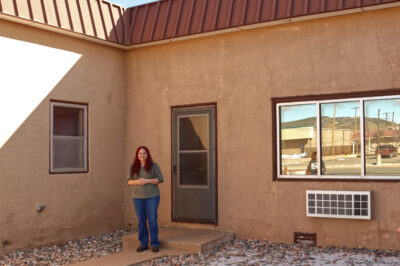by Nancy Christofferson COLORADO/NEW MEXICO — Estafana Bent Hicklin, the subject of this space in the September 3 issue of the World Journal, was the daughter of Charles Bent and Ignacia Jaramillo. The couple had two other children. Estafana also had two half-siblings.
COLORADO/NEW MEXICO — Estafana Bent Hicklin, the subject of this space in the September 3 issue of the World Journal, was the daughter of Charles Bent and Ignacia Jaramillo. The couple had two other children. Estafana also had two half-siblings.
Maria Ignacia Jaramillo was born in 1815 to an old and distinguished Taos family. In 1829 she married Jose Rafael Luna, a shopkeeper and head of the customs house in Taos. Their only child was Maria Rumalda, born in 1831. Not long after her birth, Rafael died. Ignacia, as was the custom then, converted back to her maiden name.
In fact, the list of Jaramillo extended family members reads like an early Who’s Who in New Mexico and Colorado.
Ignacia was noted by early visitors from the United States to Taos as a singular beauty. She had grace and charm as well, so it’s no wonder she caught the eye of Charles Bent. Charles was a member of the Bent brothers company that built several fortified trading posts along the Arkansas River in Colorado during the 1830s. He was a regular visitor to Taos. He and Ignacia were said to be married in late 1835 or early ’36, although there are no church or legal records. Their son Alfred was born in February 1837, Estafana in August 1939, and Maria Teresina in November 1841. Two other children died in infancy. Despite the lack of marriage records and the fact the children were baptized as “natural” children of Ignacia Jaramillo, the children were known as Bents.
In September 1846 Bent was named first civil governor of New Mexico. He would not hold office for long, however.
Estafana was eight and Teresina five years old in January 1847 when their home in Taos was attacked by rebels and their father grievously injured and scalped alive in front of them. Their older half-sister, Rumalda, was also present, as was Ignacia’s sister Josefa, best known as Mrs. Kit Carson whose husband was guiding troops to California. Young Rumalda held her dying step-father before friends hustled her into an adjoining house and hid her and the others from the mob.
Rumalda Luna married Thomas Oliver Boggs in May 1846 when she was 15 and he 21. Boggs was the son of a Missouri governor Lilburn Boggs and his wife Panthea, the granddaughter of Daniel Boone. Tom was an employee of the Bent brothers and Ceran St. Vrain. He had arrived in New Mexico in 1844.
Following Bent’s grisly death, Boggs represented the only male member of the family, and thus guardian to the women and children. They remained together in Taos until the trial for Bent’s murderers was completed with a death sentence conferred on 15 rebels. Ignacia (whose uncle, Cornelia Vigil, partner of Ceran St. Vrain in the southern Colorado land grant, was also killed), Rumalda and Josefa were called as witnesses.
After this, Tom went to California to visit his parents and realized he, too, would like to live there. In 1850 he moved Rumalda and their young son to Bodega Bay. They returned to New Mexico in 1855 and Tom went into business with Kit Carson and Lucien Maxwell in Rayado and later, Cimarron.
Rumalda was the recipient of more than 2,000 acres south of the Arkansas River on the Purgatoire from her deceased godfather and great-uncle, Cornelio Vigil. The family moved there in the mid-1860s. The little settlement that grew around the family’s homes became known as Boggsville. Their next door neighbor was John Prowers and his Cheyenne wife, Amache.
In 1868 new neighbors arrived. They were the ailing Kit and Josefa Carson and family. Josefa died in childbirth there in April and Kit, who was moved to nearby Fort Lyon, followed her in May. Tom Boggs was legal guardian of their five young children so he and Rumalda raised them as their own.
The Boggses, by 1875, were running some 17,000 sheep on their ranch so Tom is considered the “father of the sheep business” in Bent County, Colorado. He was the first county sheriff in 1870 and served in the state legislature.
Like Estafana, Rumalda and Tom were the losers when the federal government questioned the original ownership of the Vigil and St. Vrain land grant. Although they did not lose the ranch outright as Estafana had, they moved on. They went first to Willow Springs south of Raton, then to Springer, and finally to the Clayton area where they died, Tom in 1894 and Rumalda in 1906.
Teresina, the youngest witness to Bent’s brutal murder when she was just five, became the ward of Ceran St. Vrain and Kit Carson. Charles Bent had amassed a considerable amount of money and property before his death, and his assigned guardians used the estate wisely for the children. When the Academy of the Sisters of Loretto was established by Bishop Lamy in Santa Fe in 1852, Teresina and sister Estafana were enrolled as students. It was said Teresina was especially good at music, notably the piano, literature, penmanship and needlework. Like her mother and Aunt Josefa, she was a beauty. Her natural talents and composure also served her well.
When Teresina was 17, she met a young German native named Aloys Scheurich, a trader in Taos. They shared the love of music and in fact, Scheurich was believed to own a genuine Stradivarius violin which was bound to attract a music-loving maiden. They wed in 1860 and moved to an old house on what is now called Teresina Street to the northwest of the Taos plaza. Eventually, the home would boast 29 rooms to house the family and their servants. One large room was set aside only for musicales. In 1868 Teresina was given a rosewood grand piano, shipped by wagon from St. Louis, from her husband, so the couple truly “made beautiful music together.” As the years went by, many of the furnishings of the Scheurich house were shipped from the east to join in her home her treasured dower chest and trunk covered with rawhide and a desk and mirror that had belonged to her uncle Kit.
Teresina also was very fond of plants and flowers. Her patio was filled with colorful blooms and she ordered and received the first seed packet – a novelty – mailed to Taos.
Teresina and Aloys eventually had nine children, though only four survived to adulthood. All were born in Taos except Lena, who arrived in 1869 on the Colorado plains and was received on a bed of buffalo skins in the back of a wagon while Teresina and Aloys were on a trip to Las Animas, no doubt to visit her sister Rumalda Boggs.
Teresina in later life claimed to be born in 1842, just as Estafana liked to say her natal date was 1844. Church records, however, show Maria Teresa Jaramillo, “natural daughter of Maria Ygnacia Jaramillo, was baptized Oct. 26, 1841. Estafana had received the rite on Aug. 4, 1839.
Ignacia was either forgetful or particularly fond of the name Rumalda, because another Maria Rumalda Jaramillo was born to her Oct. 9, 1850. This Rumalda was not a Bent, since Charles had been dead for nearly three years, so there is some conjecture over the identity of the father.

Estafana’s sisters
More from NewsMore posts in News »




